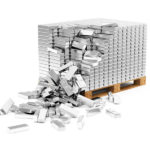Why gold remains the safe haven asset in times of geopolitical uncertainty
THANK YOU FOR POSTING A REVIEW!
Your review was sent successfully and is now waiting for our staff to publish it.
(April 13, 2018 - by Jack Hammer)
Gold is famously correlated inversely to the dollar and since the dollar has been weak of late the price is relatively strong, at just over US$1,340 per ounce.
But there is an exception.
In times of significant geopolitical uncertainty, the so-called “safe haven” attractions of gold tend to override the influence of the dollar in pricing, as investors seek shelter in the world’s oldest store of wealth.
There’s no sign of this at the moment, though, although expect an immediate spike if President Trump does press the button.
Instead, markets continue to ponder the other major threat to asset prices, the potential of a trade war between the USA and China. This is likely to have less of a direct impact on gold, although on a longer-term view it is arguable that the economic risks of a trade war and its actual consequences may also highlight the attractiveness of gold as a safe haven.
But a more immediate concern to gold traders this week has been the hawkish note struck by the US Federal Reserve on interest rates. Markets already know that rates are going up, but by how much and how quickly remains a matter for conjecture.
The more aggressive the tone struck by the Fed the more jittery gold traders get. And at the moment the Fed is proving just as powerful in influencing the gold price as the threat of war in Syria, if not slightly more so.
One reason why gold can be used as an effective geopolitical barometer is that on some measures, at least, the gold market is quite small.
According to calculations made by Ross Norman at Sharps Pixley, the amount of gold produced every year is roughly equivalent to the market capitalisation of the third largest company on the London Stock Exchange, British American Tobacco, which is worth around £100bn.
The value of all the gold in the world’s vaults and in jewellery, amounts to a much larger US$7.7tn, slightly more than the value of the world’s entire issued currency.
If that sounds much larger, then it is, but only in relative terms. The value of global stock markets is put at close to US$75tn, while global debt is set at US$215tn. And even that pales against the value of the global derivatives markets, which no-one really knows, but which could be as high as US$1.2 quadrillion.
“Gold,” says Ross Norman, “to put it mildly, is a deeply minority sport that punches above its weight.”
As long as all is well in the world and financial markets can continue along a relatively benign cyclical path that nevertheless follows a trajectory of general growth, then all will be well.
But if the jungle drums of war start beating loudly, then uncertainty rises and the gold price does too.
That’s not just because the value of other assets becomes more questionable, or because earnings and profits are likely to fall.
It’s also because the dangers of that huge derivatives book unwinding suddenly leap back into the forefronts of investors’ minds.
Warren Buffet calls derivatives as they are currently structured “weapons of mass destruction.” Not everyone agrees with that view, but it is reasonable to concede the risks posed by a major and sudden shock to the global system of trade and commerce such as full-blown war between Russia and America. The financial consequences of that might make the global financial crisis seem like a walk in the park.
Historically, cattle, land and gold have been the three great stores of wealth. Real estate has held its relative value more than cattle, but it is less easily exchanged.
For the risk-averse, gold remains the only significant option, however much of a “minority sport” it may be.
-
Silver Remains On The Defensive Below $27.50 On Easing Middle East Tensions By
Mint State Gold
April 24 2024






